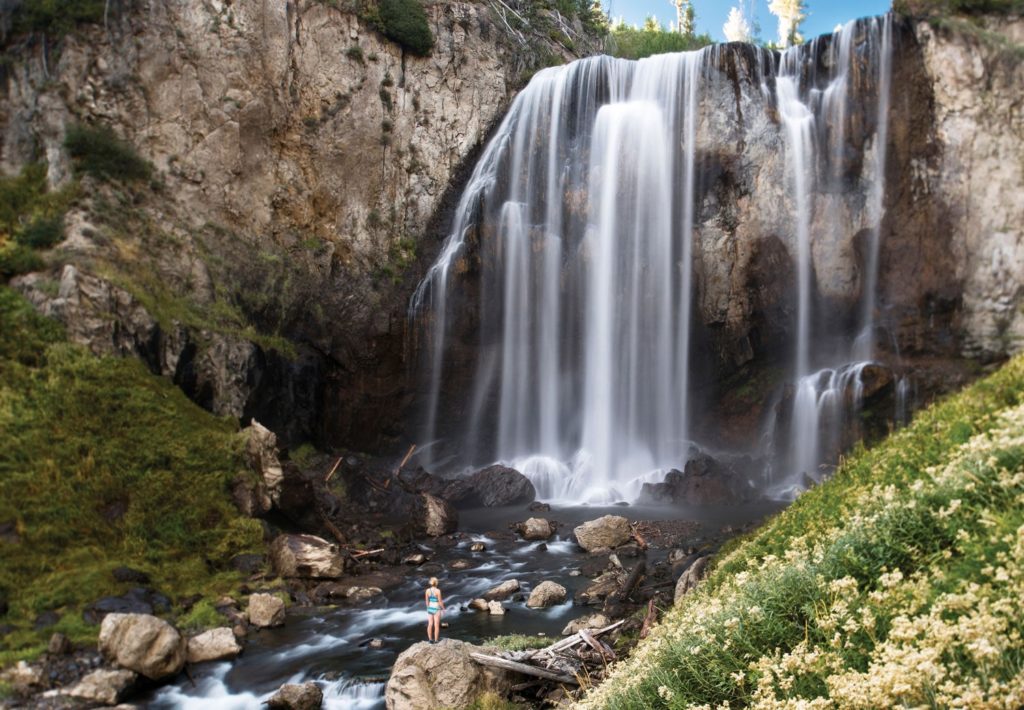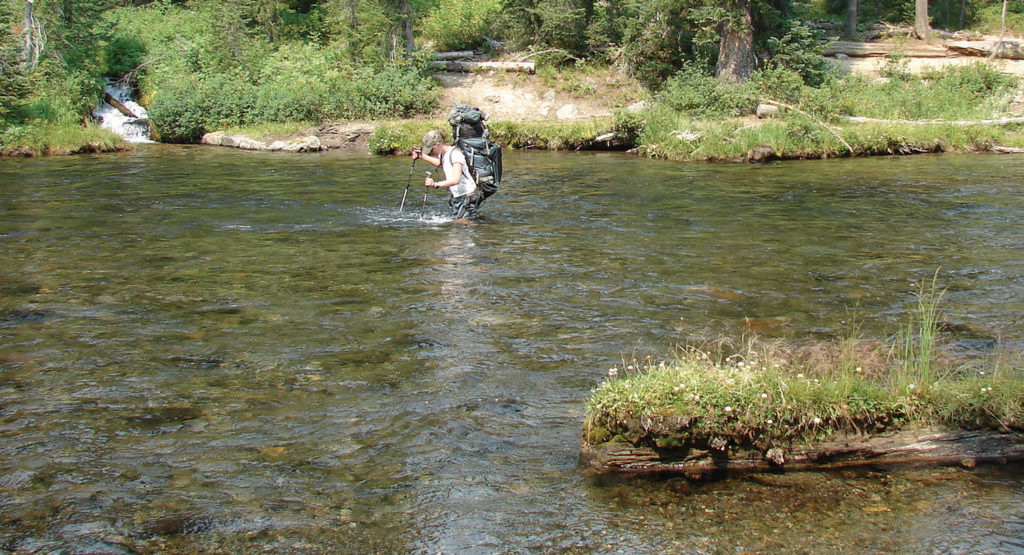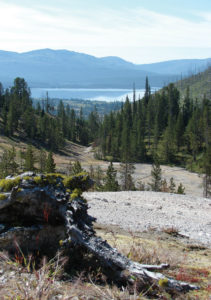
14 Jun Beyond the Boardwalk
Backcountry excursions in Yellowstone National Park
From our perch on a hillside overlooking the upper Lamar River Valley, my friend Mariann and I watched the sun set behind Parker Peak. The sky burned in reds and oranges, made more beautiful by the wildfire smoke in the distant west. We had spent most of the day wandering around the fabled Hoodoo Basin, a geologic wonderland in a park full of wonders, and were enjoying a quiet evening of tea with stellar views in Yellowstone National Park’s backcountry.

Iris Falls is one of many waterfalls along the Bechler river trail. Photography: Ben Pierce

Those getting into the back- country will enjoy a Yellowstone that few others experience. Photography: Melynda Harrison
The hoodoos are eroded rock features that resemble anything from gargoyles, camels, and trolls to World War II bomber pilots. You have to walk around the basin and view them from various angles and at different times of the day to truly appreciate it. We started at sunrise and returned in late afternoon to watch the light and shadows alter the formations. Photos and descriptions don’t do it justice, so Mariann and I spent two days exploring this little bit of backcountry.
Yellowstone gets over 4 million visitors a year, but up here in the Hoodoo Basin and surrounding area, we didn’t see anyone during our five days of wandering around. While you wouldn’t want to miss Old Faithful or the Grand Canyon of the Yellowstone, you can’t get the whole Yellowstone experience if you don’t leave the boardwalk in the world’s first national park.

the geologic formations in Yellowstone’s hoodoo Basin surprise and delight, making the long hike in worth the work. Photography: Melynda Harrison
Getting off the beaten path (or the recycled plastic boardwalk, as the case may be), takes preparation, but it’s worth the effort. Yellowstone’s trails lead past waterfalls and hot springs, they climb mountains and descend into canyons. They lead visitors through flower-filled meadows and around lakes where otters chase spawning trout.
According to the National Park Service, there are more than 900 miles of trails in Yellowstone. While the abundance of backcountry opportunities is a boon to anyone who wants to get away from park crowds, it can be hard to know where to start. Below is a sampling of some classic trips. So take your photos of Old Faithful, but then hop on a trail and have an adventure to remember.
Yellowstone River Trail
The Yellowstone River Trail is a great early-season hike at the north end of the park. Because of its relatively low elevation, it dries out before the rest of the park. Abundant wildflowers in spring and early summer, skulls from elk and bison that didn’t make it through the winter, waterfalls, and the Yellowstone River accompany the hiker on this trail, and there is good fishing once the river goes down in mid-summer.

Visitors to Dunanda Falls in the Bechler area of the park will find the perfect place for a dip in Boundary Creek. Photography: Ben Pierce
The trail can be accessed from several points, depending on how long you want to walk and what you want to see. Sections can be accomplished as day hikes, or backpackers can walk the whole thing, spending the night at backcountry campsites.
For an easy three-day backpacking trip, start at Hellroaring Trailhead, hike about 6 miles each day, and end at the Eagle Creek Campground near Jardine, Montana. This through-hike requires a shuttle.
For a delightful — although steep — day hike, start at the Blacktail Creek Trailhead and walk 3.7 miles down to the Yellowstone River. From there, you can cross the suspension bridge to the overlook of Crevice Lake. Turn around here or continue to Knowles Falls, 5.5 miles from the trailhead.

Photography: Melynda Harrison
Hoodoo Basin
It’s not easy to get to Hoodoo Basin, what the first paid superintendent of Yellowstone, Philetus Norris, called a “Goblin Land” when he visited. But it’s worth the effort to explore the meadows, mountains, and strange geological formations in this remote corner of the park.
From the Soda Butte Trailhead in the Lamar Valley, travel 7.5 miles along the Lamar River Trail, then 7.9 miles on the Miller Creek Trail, and 0.7 miles on the Bootjack Gap Trail. Alternatively, you can hike in from Sunlight Basin off the Chief Joseph Highway. Depending on how far you can get up the road in your car, it’s a 12- to 15-mile hike. The second route is shorter and more scenic, but there is a steep hill climb involved.
Bechler River Trail
The Bechler River runs through what’s known as Cascade Corner in the southwest section of Yellowstone. Not surprisingly, the trail passes several spectacular waterfalls, hot springs (including one you can soak in), and scenery that grabs you and won’t let go. One note of warning: There are two major river crossings, and the mosquitoes can be terrifying. This trail is best hiked in August.
The trail in entirety is 30 miles long. It starts at the Lone Star Trailhead and terminates at the Bechler Ranger Station on the southern boundary of the park. Take five days and four nights to allow for the long drive to the trailheads (you will need to arrange a shuttle), and a morning to soak in Mr. Bubbles, a rightfully famous backcountry hot spring.
Heart lake

heart lake is remote but rela- tively easy to access, and the lake views make the trek worth the effort. Photography: Melynda Harrison
This 2,160-acre lake is in Yellowstone’s remote Thorofare region in the southeast corner of the park. Although the Thorofare Ranger Cabin is reported to be the most remote place in the Lower 48, the Heart Lake Trail is popular. Still, it’s much less crowded than any of the geyser basin boardwalks.
Start at the Heart Lake Trailhead and hike 7.5 miles to the expansive lake, passing hot springs and steaming hillsides along the way. The first 5 miles through unburned forest can feel a little long, but it’s worth it when you get a big view of the lake and wilderness beyond.
To make it an overnight trip, camp at the lake for a couple of nights and climb Mount Sheridan (3.3 miles and 2,700 feet to the summit) on the layover day. Or make it a lollipop loop by hiking around Heart Lake (33.4 miles round trip from the trailhead). There are also a number of options for multi-day trips starting at Heart Lake. The trailhead usually doesn’t open until July 1 since this is a bear management area, and the mosquitoes are abundant until mid-August.
Tips for navigating Yellowstone’s Backcountry
Whether you choose a day hike or a backpacking trip, navigating Yellowstone’s backcountry takes preparation and alertness.
Planning: The first step is choosing a route. Look through one of the many trail guidebooks available for Yellowstone, such as Hiking Yellowstone National Park by Bill Schneider, which describes the campsites and lays out classic trips. Rangers in the visitor centers are happy to look at a map with you and point out trails.
Permits: Day hiking does not require a permit, but camping in the backcountry does. When backpacking in Yellowstone, you must stay at one of the park’s 300-plus backcountry campsites.

a soak in the backcountry hot springs known as Mr. Bubbles, in the Bechler region, is a reward for leaving the boardwalk and cover- ing miles. Photography: Melynda Harrison
Campsites: For overnight trips, choose the campsites you want to stay in based on location and hiking distance. When applying for a permit, you’ll need to indicate which campsites you want to use.
Reservations: Some campsites may be reserved in advance. Reservations are accepted from January 1 to October 31 of each calendar year, and those received by March 31 will be processed in random order starting April 1. Reservations received on or after April 1 will be processed in the order they’re received after the random lottery is complete. There is a $25 fee to apply for a permit this way, plus the regular permit fees if you get a site.
Guides: If you want to get into the backcountry, but aren’t prepared to go it alone, check the park’s website for approved backcountry guides who can lead you on foot, horse, or boat.
Walk-Ins: If you don’t make a permit reservation, you can walk into any of the backcountry offices in the park and request a permit. Popular campsites will likely be booked, so have a second itinerary in mind. Between Memorial Day and September 10, permits cost $3 per person per night with a maximum of $15 per night for a group.
Bear Spray: Everywhere in Yellowstone is bear country. You need to carry bear spray and know how to use it, whether you are day hiking for a half mile or spending a week on the trail. Bear spray can be purchased at almost any store in the park, many shops outside the park, or rented from a kiosk in Canyon Village.
Bear Aware: Make noise while you are hiking (using voices, not bear bells) in order to give bears a chance to avoid you. Know how to hang your food properly and how to camp in bear country. Yellowstone’s campsites have “bear poles” or bear boxes, but you’ll need to bring your own rope. When you pick up your permit, you will be required to watch a video about hiking and camping around bears, but it’s worth doing some research on the park’s website ahead of time.
Water: Plan for how you will get water. If you are hiking near rivers, creeks, or snowpack, you can easily access water, although you will need to treat it before drinking, cooking, or brushing your teeth with it to avoid giardia or other nasty intestinal bugs. Some places don’t have easy water sources and you may need to carry your own.
Leave no trace: Even though Yellowstone’s backcountry looks pristine, it only stays that way if we care for it. Pack out everything you pack in, stay off fragile areas, and respect plants and wildlife.



No Comments